Here you can find the names and images of Purple Fuzzy Plants with pro tips for growing them.
Fuzzy purple house plants are very popular among indoor gardeners they are strange and wealthy appearances. Most people after spotting one of them, like to add it to their living space, but what are their names?
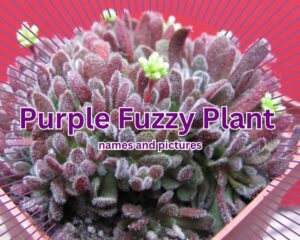
In this article, you will get familiar with the names and pictures of 8 purple fuzzy plants. The colour of the fuzzy purple house plant is usually variegated in various lighting conditions. Hence you usually them as a green and purple fuzzy plant. Some of them are very easy growing and others need an experienced gardener. Therefore, I tried to provide you with points about their requirements.
If you are ready, let to know more.
What plant has purple fuzzy leaves?
Here, you can see the 8 fuzzy purple house plant names and pictures.
Purple Passion Vine
Other common names: velvet plant or purple velvet plant
Scientific name: Gynura aurantiaca
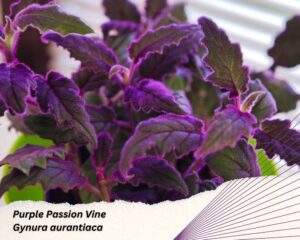
Gynura aurantiaca has fuzzy purple and green leaves with small yellow flowers. Indeed, the leaves are dark green that are covered by purple hairs. The color of the leaves is influenced by the amount of sunlight. Purple passion (velvet) plant is one of the easy caring indoor plants.
Below, you can see its important caring tips.
| Requirements | Caring tips |
| light | bright indirect light |
| watering | The best time for watering is everywhen the several inches of topsoil dries out. |
| Temperature | Purple passion is a tropical plant, hence it cannot tolerant temperatures below the 59°F (15 °C) |
| Humidity | Although purple passion can grow in low humidity conditions it has the best growing in moderate to high humidity levels. |
| Soil | The ideal soil for the velvet plant is moist, rich soil with good drainage. The acidity of soil should be between 6.1–6.5 pH |
| Fertilizer | Use a balanced fertilizer ratio such as 10-10-10 or 20-20-20 during the growing season. |
| Propagation | Stem cutting |
Baby Bunny Bellies
Scientific name: Tradescantia chrysophylla
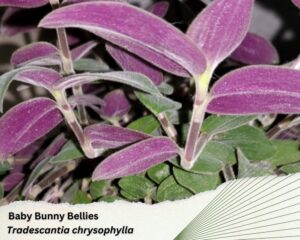
Baby Bunny Bellies is a popular hanging plant with green and purple fuzzy leaves and eye-catching tiny white flowers. It can be an idea to choose for your office because Baby Bunny Bellies is a very easy-caring indoor plant.
In the following, you can find out the important caring tips for this beautiful houseplant.
| Requirements | Caring tips |
| light | Tradescantia chrysophylla needs a bright indirect light |
| watering | In the growing season, you should water it when the one inch of topsoil dries out. |
| Temperature | 62-85F (17-30 C) |
| Humidity | It needs moderate to high humidity levels. So, you should put its pot in a shallow saucer full of water and pebbles. |
| Soil | It needs good drainage soil that contains organic matter. |
| Fertilizer | You should fertilize it with a balanced, liquid fertilizer once a month during the growth season. |
| Propagation | Stem cutting |
Fuzzy Wandering Jew Plant
Scientific name: Tradescantia pallida ‘Purple Fuzzy’

One of the easy-growing indoor and outdoor vine plants. The color of the fuzzy leaves is green and purple depending on the lighting conditions. You may see between the leaves their gorgeous white, pink, or purple tiny flowers.
| Requirements | Caring tips |
| light | Tradescantia pallida ‘Purple Fuzzy’ needs a lot of bright indirect light to maintain its color. |
| watering | They love the moist but not (soaking and soggy) soils. This plant cannot tolerate dried soils, although don’t like sitting its roots in water. |
| Temperature | They can easily tolerate 50-80°F (10-27°C) |
| Humidity | Fuzzy Wandering Jew Plant loves the high humidity levels. |
| Soil | They thrive in a regular (standard) house plant potting soil. |
| Fertilizer | You should fertilize it once a month with organic fertilizers. They may be sensitive to some chemical fertilizers. |
| Propagation | Stem cutting |
Iron-Cross Begonia
Scientific name: Begonia masoniana
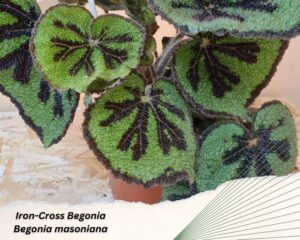
It is a kind of begonia with green fuzzy leaves and purple to maroon patterns on it. in the following, you can see the important tips that help you to have a healthy Iron-cross begonia.
| Requirements | Caring tips |
| light | They love shade to medium indirect sunlight |
| watering | They hate over-watering and much water. In summer, weekly watering is enough. |
| Temperature | They can grow at 24 – 28 degrees Celsius |
| Humidity | They love humid conditions with 70 – 90 % humidity. |
| Soil | They thrive in a normal potting mix with a low PH. |
| Fertilizer | You should fertilize it once a month only during the growing season. |
| Propagation | leaf cuttings. |
Begonia Baik
Scientific name: Begonia baik
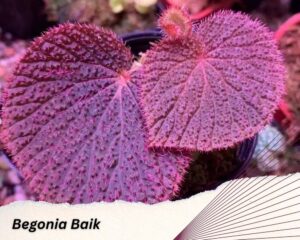
It is a rare colorful houseplant with fuzzy leaves. Begonia baik is not an easy-growing indoor plant, hence caring for it is not easy for new gardeners.
| Requirements | Caring tips |
| light | Tradescantia pallida ‘Purple Fuzzy’ needs a lot of bright indirect light to maintain its color. |
| watering | They love the moist but not (soaking and soggy) soils. This plant cannot tolerate dried soils, although don’t like sitting its roots in water. |
| Temperature | They can easily tolerate 50-80°F (10-27°C) |
| Humidity | Fuzzy Wandering Jew Plant loves the high humidity levels. |
| Soil | They thrive in a regular (standard) house plant potting soil. |
| Fertilizer | You should fertilize it once a month with organic fertilizers. They may be sensitive to some chemical fertilizers. |
| Propagation | Stem cutting |
Purple Sage
Scientific name: Salvia officinalis ‘Purpurea’
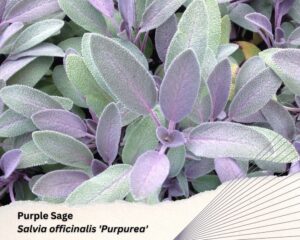
Although you may grow Purple Sage indoors, it is a perfect fuzzy purple plant for growing outdoors and you can add them to your landscape design. Salvia officinalis ‘Purpurea’ is an easy-growing plant too.
| Requirements | Caring tips |
| light | Salvia officinalis ‘Purpurea’ love the full sun condition however it can tolerate shade area too. |
| watering | They love regular watering although hate over-watering and prefer to thrive in dry to medium moisture. |
| Temperature | In winter, they can tolerate -15 C. |
| Humidity | Purple Sage can tolerate drought environments too. |
| Soil | They thrive in well-drained soil. |
| Fertilizer | They don’t need fertilizing and adding a little compost will be good for their healthy thrive. |
| Propagation | Stem cutting |
Columnea purpureovittata
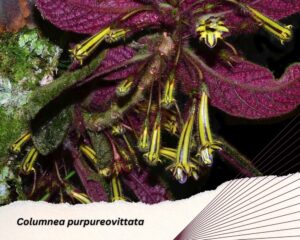
Columnea purpureovittata is a hairy fuzzy purple house plant with leaves that are green on the upper surface and purple on the underneath. This wonderful plant has long trampoline-shaped yellow flowers with deep purple lines. Growing this plant is difficult.
| Requirements | Caring tips |
| light | Columnea purpureovittata likes to grow semi-shaded in light areas. |
| watering | You should water them regularly but this plant hates its roots to sit in water. However, this plant likes moist (not soaked) soils. |
| Temperature | They like to 40 degrees Fahrenheit. |
| Humidity | This plant like quite high humidity. |
| Soil | They like to have well-drained soils with peat moss and perlite. |
| Fertilizer | You should fertilize it regularly. |
| Propagation | Stem cutting |
Jersey Pigmyweed
Scientific name: Crassula pubescens subsp. Rattrayi
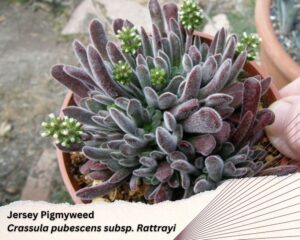
Jersey Pigmyweed is a fuzzy purple houseplant that can thrive outdoors too. In the following, you can read their caring conditions.
| Requirements | Caring tips |
| light | Jersey Pigmyweed must be planted in full to partial-sun areas. |
| watering | This succulent needs a small watering and you should avoid over-watering. |
| Temperature | They are frost-resistant and tolerate to 23˚F (-5ºС). |
| Humidity | It is tolerated to heat and drought-tolerant and humid conditions and can be harmful. |
| Soil | They can thrive in a variety of soil types but have to be well-drained. |
| Fertilizer | You should fertilize it once a month with liquid succulent fertilizers. |
| Propagation | cuttings, leaves, offsets, or seeds. |
Conclusion
Now, you got familiar with fuzzy purple houseplants including purple and green fuzzy plants that belong to Purple Passion Vine, Baby Bunny Bellies, Fuzzy Wandering Jew Plant, Iron-Cross Begonia, Begonia Baik, Begonia Baik, Purple Sage, Columnea purpureovittata, Jersey Pigmyweed.
Which one of them is your interest house plant? Which one have you ever grown in your house? Please share your experience with us.

Elahe Rabiei
Hi, I’m Elaheh. My Academic major is plant protection, and houseplants are my expertise. As a houseplant lover, my house is full of indoor plants and it is my passion to take care of them. Hence, I’m here to share my knowledge and experience about growing healthy houseplants. I am also a plant protection advisor, so feel free to ask me any questions you may have.

